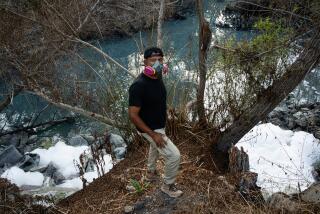Researchers Sound Nationwide Alarm Over Acid Rain
- Share via
If environmentalists and New York’s congressional delegation have any hope of winning approval of a new set of acid-rain controls, it is because scientists are beginning to document environmental effects in other parts of the country.
Acid rain has always been a regional political battle because the biggest pollution sources are in the Midwest and the most heavily damaged areas are in the Northeast. Emissions from the giant coal-burning power plants of the Ohio Valley drift hundreds of miles downwind before falling back to the ground, usually in the form of rain.
The tainted raindrops fall in a huge area stretching from Illinois to Maine that includes Long Island, where a typical rainfall has a pH of about 4.3, which is about as acidic as a carbonated drink and more than 10 times as acidic as unpolluted rain. But the damage is most obvious in the high lakes of the Adirondacks, where rain and snow are plentiful, soil quality is poor and there is often not much water circulation. Unlike water bodies in other parts of the Northeast, many lakes in the Adirondacks are almost as acidic as the rain that falls into them, which makes them the nation’s most dramatic example of acidification.
Lately, however, scientists have been able to tease out more subtle effects of acid rain in other
places. In western Long Island Sound, for example, where nitrogen pollution routinely causes late-summer fish kills, acid rain is estimated to be the source of about one-fifth of all the man-made nitrogen that reaches the estuary. And earlier this year the state put consumption limits on bass caught in three of New York City’s reservoirs in the Catskills--the Ashokan, the Neversink and the Rondout--after finding unsafe levels of mercury in fish, apparently because of acid rain. (The water is still considered safe to drink.)
In the Great Smoky Mountains, acidified clouds that hang low over the tallest peaks are killing pine trees and decreasing visibility, and acid rain is damaging pines outside Los Angeles and red spruce throughout the Northeast. Last year, the EPA even put out a pamphlet that gives the route for a walking tour of marble and limestone monuments in Washington, D.C., damaged by acid rain, including the Capitol.
“People are realizing now that this problem exists from Maine to Georgia, and even in the West,” said Bernard Melewski, legislative director of the Albany, N.Y.-based Adirondack Council. The group is running radio advertisements supporting a bill by U.S. Sen. Daniel Patrick Moynihan (D-N.Y.) that would mandate deeper cuts in emissions of sulfur dioxide and nitrogen oxides.
In addition to mandating much deeper cuts in nitrogen oxides and some additional reductions in sulfur dioxide, the Moynihan bill would set up a cost-cutting “emissions trading” program for nitrogen oxides similar to the one for sulfur dioxide. The trading scheme allows utilities that reduce their emissions beyond their EPA-assigned allowances to sell the surplus to other utilities, which can use the “credits” to avoid cutting their own pollution by the same amount.
More to Read
Sign up for Essential California
The most important California stories and recommendations in your inbox every morning.
You may occasionally receive promotional content from the Los Angeles Times.








